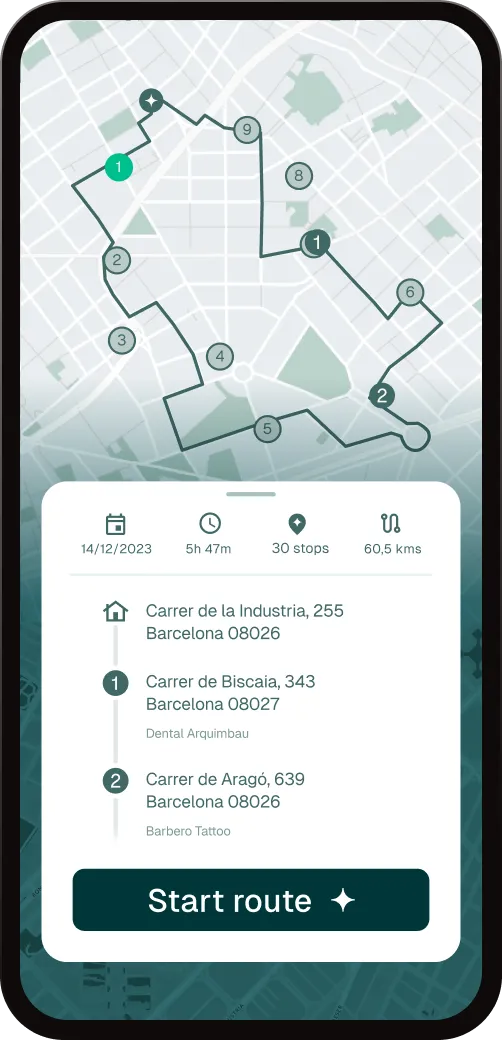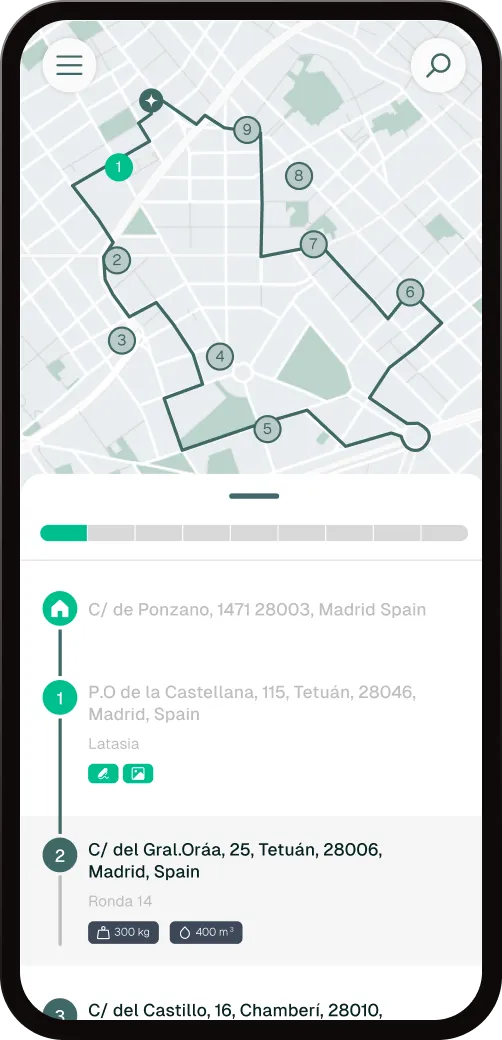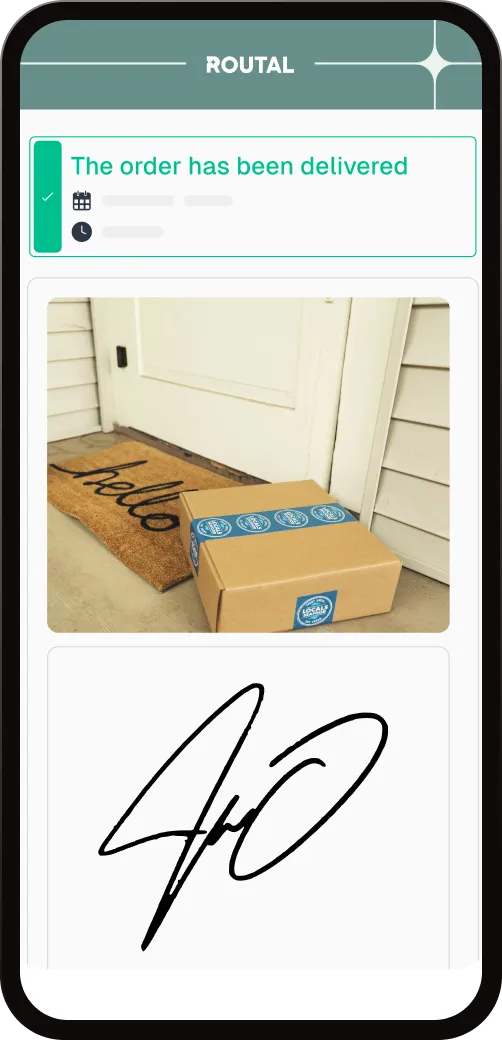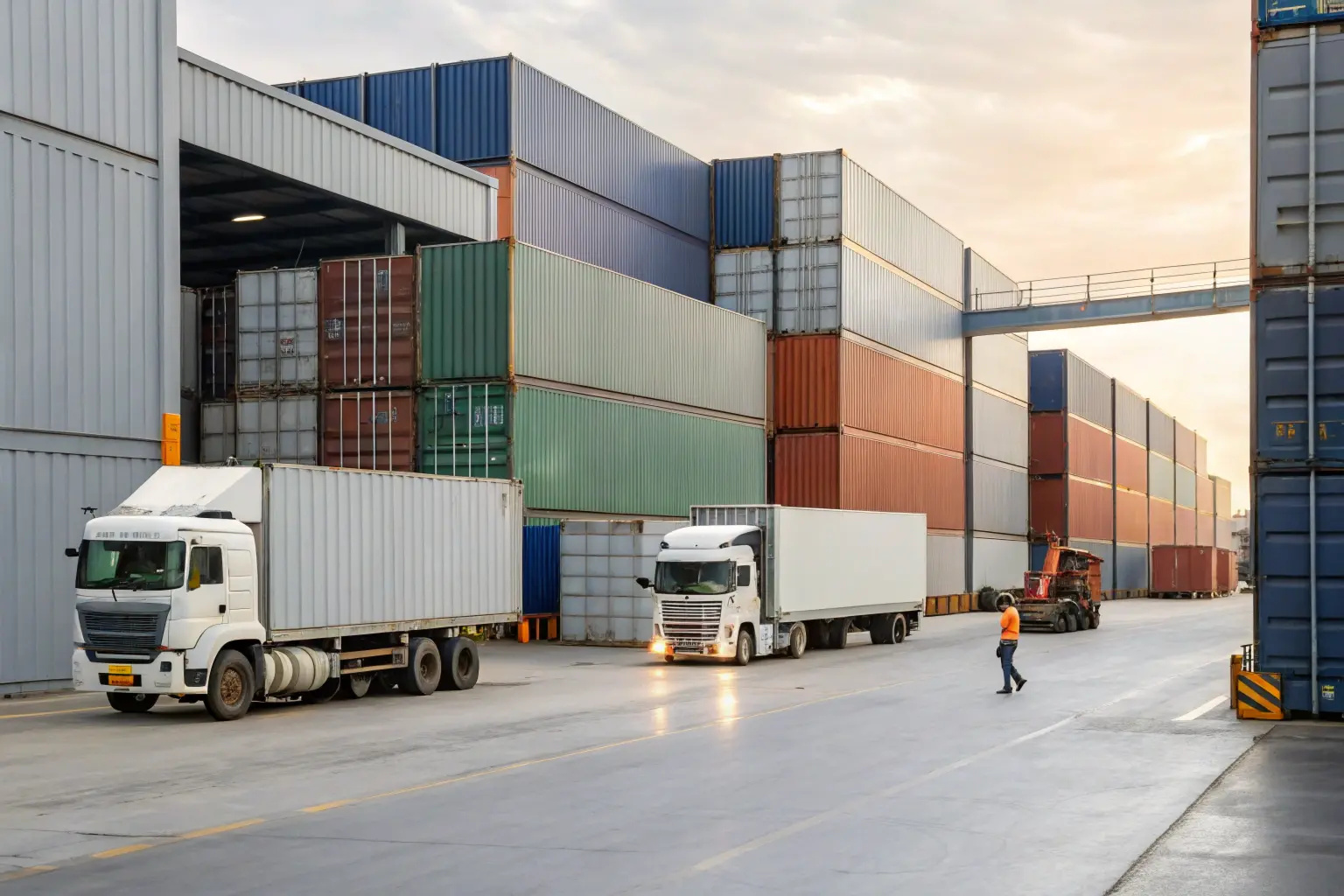Plan better routes in UAE

Plan and optimize your routes in seconds.
Monitor drvers in real-time





















Automate all your last-mile processes
You'll have all the parameters you need to give you the best results instantly.
Finally a simple planner that you can use today.

The drivers they only need a cell phone and internet access.

Raise the customer experience.
Precise updates.


We help large and small companies in . Thank you!














Optimize your routes in 3 clicks
Success stories, transformative results.
Our latest news and industry know-how.

Los logistics operators they play a fundamental role in the supply chain, since they are responsible for manage, coordinate and streamline the flow of goods and services from origin to final destination. Its function can range from basic tasks, such as warehousing and transportation, to the comprehensive management of all the logistics of a company, including technology, consulting and process optimization.
Depending on the degree of integration and control that the logistics operator has over a company's operations, we can distinguish:
1PL Logistics Operator (First Party Logistics - First Party Logistics)
La First Party Logistics (1PL) It is the model in which a company manages its own logistics activities without the intervention of third parties. This means that the company is directly responsible for transporting, storing, distributing and managing its products from their origin to their final destination.
This model is primarily used by companies with great operational capacity who can afford to invest in their own logistics infrastructure.
Key Features of 1PL
Total self-management: The company owns and manages its own logistics resources, such as truck fleets, warehouses and distribution centers.
High initial costs: Requires significant investment in infrastructure and logistics personnel.
Examples of Companies Using the 1PL Model
Coca-Cola:
• The company manages its own distribution network with factories, warehouses and a fleet of trucks to take its products to the points of sale.
Zara (Inditex Group):
• It controls its own supply chain with its own logistics centers and direct distribution to its stores in different countries.
Nestle:
• The company manages its own production and distribution chain in several markets, ensuring the efficient supply of its products.
Advantages of the Model 1PL
Greater control over the supply chain.
Long-term cost reduction (by eliminating intermediaries).
Better time management and quality of service.
Optimization of infrastructure and logistics personnel.
Disadvantages of the Model 1PL
High initial investment costs in infrastructure and vehicles.
Complexity in logistics management (need for experts and advanced technology).
Less flexibility to adapt to market fluctuations
Logistic Operator 2PL (Second Party Logistics)
La Second Party Logistics (2PL) refers to when a company outsourced specific logistics services to a specialized supplier. In this case, The company continues to manage its logistics, but outsources key functions to specialized operators to improve efficiency and reduce costs.
This model is common in companies that do not want to invest in their own logistics infrastructure, but that need to ensure an efficient distribution of their products.
Key Features of 2PL
Outsourcing key services: Companies specialized in transportation, storage or distribution are outsourced.
Focus on operational efficiency: It allows companies to optimize their logistics without making large investments in their own infrastructure.
Functions that a 2PL Logistics Operator can perform
- Freight transport.
- Storage and stock management.
- Loading and unloading management.
- Management of customs and international procedures.
- Multimodal transport (combination of different types of transport).
Examples of 2PL Companies
DHL Freight (land transport):
• Companies that need to move goods nationally or internationally can subcontract to DHL for ground transportation.
Maersk (maritime transport):
• Many manufacturing and foreign trade companies use Maersk to ship goods through containers by sea.
UPS Supply Chain Solutions (storage and distribution):
• Companies that don't have their own warehouses can use UPS fulfillment centers to manage inventories and distribute products.
FedEx Logistics (air transport and cargo solutions):
• Companies that require urgent shipments hire FedEx to make international deliveries by air transport.
GLS, SEUR or MRW (transport and parcel delivery):
• E-commerce or retail companies use last-mile transportation services from operators such as GLS or SEUR to deliver products to customers.
Advantages of the 2PL Model
Lower investment in infrastructure.
Flexibility and scalability.
Access to specialized expertise.
Expansion to new markets.
Disadvantages of the 2PL Model
Less control over the logistics chain.
Possible delivery delays.
Variable costs depending on the volume of operations.
Risk of loss of key information.
Logistics Operator 3PL (Third Party Logistics)
La Third Party Logistics (3PL) It is a model in which a company outsource the complete management of your logistics to a specialized supplier.
Unlike the model 2PL, where only specific functions are outsourced, in 3PL the logistics operator becomes a strategic partner, managing a significant part of the supply chain, allowing companies to focus on their core business while leaving logistics in the hands of experts.
Key Features of 3PL
Total outsourcing of logistics: An external supplier is responsible for the storage, transportation and distribution of products.
Integrated management: The 3PL operator coordinates multiple logistics functions within the supply chain.
Functions of a 3PL Logistics Operator
- Transportation and Distribution Management.
- Storage and Inventory Management.
- Order Preparation (Pick & Pack).
- Customs Management and International Trade.
- Analysis and Optimization of Logistics Processes.
Examples of 3PL Companies
Amazon FBA (Fulfillment by Amazon):
• Companies and online sellers use Amazon's 3PL service to store their products in their fulfillment centers and manage shipping, returns and customer service.
DHL Supply Chain:
• Provides storage, distribution and customized logistics solutions for multiple industries.
UPS Supply Chain Solutions:
• Manages the logistics of retail, e-commerce and manufacturing companies, offering transportation and storage.
XPO Logistics:
• Specialized in storage and transport logistics for industrial and retail companies.
CEVA Logistics:
• It operates globally offering transportation, distribution and storage solutions for technology, automotive and consumer goods companies.
Advantages of the 3PL Model
Reduced operating costs.
Greater efficiency and specialization.
Scalability and flexibility.
Focus on the core business.
Access to advanced technology.
Disadvantages of the 3PL Model
Less control over logistics.
Variable costs.
Risk of supply chain failures.
It can be difficult to synchronize company systems with those of the logistics provider.
Logistics Operator 4PL (Fourth Party Logistics)
La Fourth Party Logistics (4PL) is an advanced model of logistics outsourcing in which a company hires a specialized supplier or consultant for you to manage and optimize your entire supply chain.
Unlike the 3PL, where the operator only functions logistics, in 4PL the supplier is responsible for coordinating different logistics operators (3PL, carriers, warehouses, customs, etc.) to offer a comprehensive solution.
This model is ideal for companies looking for fully optimized logistics management, with the use of technology, data analysis and artificial intelligence to improve efficiency and reduce costs.
Key Features of 4PL
Comprehensive supply chain management: Coordinates and optimizes all logistics processes.
Use of advanced technology: Integration of systems such as ERP, WMS and TMS for analysis and decision-making.
It has no physical assets: It does not operate its own warehouses or fleets, but rather manages 3PL operators and other logistics providers.
Optimization and strategy: Focuses on improving costs, delivery times and operational efficiency.
Consulting-based model: Provides strategic analysis and recommendations for the supply chain.
Functions of a 4PL Logistics Operator
- Management and Coordination of Logistics Providers (3PL, Carriers, Customs, etc.)
- Data Analysis and Supply Chain Optimization
- Strategic Planning and Logistics Consulting
- Technological Integration and Digitalization of Logistics
- Risk Management and International Logistics
Examples of 4PL Companies
Accenture Logistics & Supply Chain Management:
• Offers consulting and supply chain optimization services for large companies.
DHL Supply Chain 4PL Services:
• Manages and coordinates multiple logistics providers for global companies, optimizing costs and delivery times.
XPO Logistics (4PL Division):
• Provides integrated solutions for the planning and logistics execution of large corporations.
UPS 4PL Solutions:
• Integrates the management of logistics operators and carriers into a single, optimized solution.
GEODIS Supply Chain Optimization:
• Specialized in logistics consulting and data analysis to improve the supply chain of its customers.
Advantages of the 4PL Model
Total optimization of the supply chain
Cost reduction and service improvement
Increased visibility and control
Long-term strategy
Increased flexibility and scalability
Disadvantages of the Model 4PL
Less direct control
High initial costs
Technology Dependency
Not suitable for small businesses
Logistics Operator 5PL (Fifth Party Logistics)
La Fifth Party Logistics (5PL) represents the most advanced level of logistics outsourcing, where an operator not only manages and optimizes the entire supply chain as in 4PL, but also integrates multiple logistics networks and advanced technologies for total automation and efficiency.
The operators 5PL focus on digitalization, artificial intelligence, big data and the optimization of global logistics, especially in sectors such as e-commerce, retail, manufacturing and international logistics.
Unlike the 4PL, where the supplier acts as a strategic supply chain manager, in 5PL the operator designs complete logistics ecosystems and uses state of the art technology to automate processes and optimize costs on a large scale.
Key Features of 5PL
Automation and total digitalization: Use of artificial intelligence, machine learning, IoT and blockchain to manage the supply chain.
Integration of global logistics networks: Coordinates multiple logistics operators (3PL, 4PL, carriers and technology providers).
Optimization based on Big Data: Analyze data in real time to improve efficiency, reduce costs and forecast demand.
Technology-based business model: It focuses on software, digital platforms and automation rather than its own physical infrastructure.
Functions of a 5PL Logistics Operator
- Optimization and Management of the Global Supply Chain
- Use of Artificial Intelligence and Machine Learning
- Blockchain and Supply Chain Security
- Sustainable Logistics Strategies and Green Logistics
- Warehouse Automation and Last Mile
Examples of 5PL Companies
Alibaba Logistics Network (Cainiao):
• Cainiao optimizes Alibaba's entire supply chain using big data, artificial intelligence and advanced automation.
Amazon Robotics & Fulfillment Services:
• Amazon deploys robots, drones and artificial intelligence systems to manage logistics on a global scale.
Flexport:
• Digital logistics platform that combines technology, artificial intelligence and blockchain to optimize the international supply chain.
Kuehne + Nagel Integrated Logistics:
• It offers digital logistics solutions based on big data, machine learning and automation.
DHL Smart Logistics Solutions:
• Develops logistics systems based on IoT, automation and big data for global customers.
Advantages of the Model 5PL
Full automation of the supply chain.
Reduction of operating costs through the use of AI and Big Data to optimize each logistics process.
Greater security and traceability through the implementation of blockchain and intelligent systems.
Greater flexibility and scalability.
Sustainability and resource optimization.
Disadvantages of the Model 5PL
High initial investment in technology.
Technological dependence.
Less direct control over logistics
Complexity in implementation.

In the world of logistics and deliveries, the route planning is key to reducing costs, improving efficiency and meeting delivery times. However, many companies continue to use manual methods or basic tools, resulting in inefficient routes, longer delivery times and high operating costs.
That's why more and more companies are adopting automated route optimizers, which make it possible to reduce time, minimize costs and improve the customer experience, obtaining a great competitive advantage compared to your competitors

Why Is Good Route Planning Important?
Planning routes efficiently not only helps reduce the number of kilometers traveled, but also has a direct impact on a company's productivity and profitability.
Here are some of the key benefits:
Time Savings in Planning
Creating routes manually can take hours, especially if you have many stops, giving the possibility of human errors that can affect the efficiency of the operation.
An automated route optimizer transforms this process into A matter of minutes. Thanks to advanced algorithms, the tool analyzes multiple factors, such as the location of destinations, traffic in real time, delivery time windows and vehicle capacity, automatically generating the most efficient route.

Reducing Operating Costs
Inefficient route planning can have a significant impact on the operating costs of any logistics or distribution company. When routes are optimized, vehicles travel fewer kilometers, which translates into:
- Lower fuel consumption
- Less wear and tear on the vehicle
- Fewer working hours for drivers
- Lower risk of delays and penalties
Faster and More Accurate Delivery
In a world where promptness is key, customers expect their orders to arrive quickly and on time. Poor route planning can cause delays, disorganization and a poor customer experience, directly impacting a company's reputation and competitiveness.
One of the biggest challenges in last-mile logistics is the unpredictability. Factors such as traffic, last-minute changes in orders, road restrictions or weather conditions can affect deliveries. If routes are not optimized, any unforeseen event can lead to cascading delays affecting all of the day's deliveries.
Un automatic route planner solves this problem by calculating the best route based on multiple factors, such as traffic, ensuring that packets arrive at their destination as efficiently as possible.
.webp)
Greater Control and Visibility
In last-mile logistics, a lack of control and visibility can create multiple problems, from unexpected delays to difficulties in communicating with customers. Without an appropriate tool, logistics managers must rely on calls or messages to know the location of drivers, which is not only inefficient, but also leaves room for errors and miscoordination.
Los route optimizers they provide a Real-time tracking of each vehicle, allowing companies to monitor their operations precisely and react quickly to any unforeseen event.
It's also critical to provide a transparent and reliable customer experience. A lack of information about the status of your order can lead to frustration and uncertainty, affecting your perception of the service. This is where the route optimizers play a crucial role in providing real-time visibility and control, through the possibility of locating the vehicle in real time or sending notifications, improving the customer experience
In addition, the flaws in the first delivery can generate additional costs, both in terms of delivery reattempts and in customer dissatisfaction. Thanks to control and visibility, this problem will be minimized.
Scalability and Adaptability
As a company expands its operation, manual route management ceases to be a viable option. What could previously be solved with a simple map and some intuition becomes a complex logistical challenge.
Logistics must adapt to the pace of the business. Route planning software offers the flexibility needed to manage from a few deliveries to thousands a day without compromising efficiency. As demand fluctuates, the technology allows the distribution of routes to be automatically adjusted, allocating deliveries optimally among available vehicles.
The growth of a company should not be accompanied by an increase in operational complexity. With a scalable and adaptable solution, it is possible to expand without logistics becoming an obstacle, allowing companies to focus on what is most important: delivering quickly, efficiently and smoothly.

Try Routal: The Simplest and Most Efficient Optimizer
Route planning can be a challenge, but with Routal, optimizing your routes is easier than ever. Our platform allows you to automate the organization of deliveries in seconds, eliminating the need to plan manually and helping you reduce operating costs. With an intuitive interface and powerful optimization technology, Routal is the ideal solution for companies looking to improve their efficiency and offer a high-quality service.

With Routal you can:
Generate optimal routes in seconds → Just enter the directions and let the system calculate the best sequence to minimize distances and travel times.
Reduce costs and improve efficiency → Optimizing routes means less fuel, less wear and tear on vehicles and more deliveries completed in less time.
Manage and monitor deliveries in real time → View where your drivers are at all times, adjust routes for unforeseen events and keep customers informed with accurate estimated arrival times.
Improve the customer experience → Real-time notifications and timely deliveries increase trust and reduce uncertainty, making customers value your service more.
But it's not just us who say that. Companies from different sectors have already transformed their logistics with Routal, achieving faster deliveries, lower costs and greater customer satisfaction.
From small businesses to large distribution fleets, Routal adapts to your needs with a clear interface and automated processes. In just a few clicks, you can enter your addresses, generate optimized routes and make adjustments in real time.
Don't let manual planning waste your time and money. With Routal, you can improve the efficiency of your operation and provide an exceptional experience for your customers.
Request your free trial today and take your logistics to the next level.

Last-mile logistics has become a strategic factor for companies seeking to stand out in an increasingly competitive market. However, ensuring fast, accurate and satisfactory deliveries does not only depend on good route planning or advanced technology; customer support plays a crucial role in this equation.
In this article, we'll explore why efficient customer service can make a difference in the consumer experience and how more and better information can improve logistics performance. In addition, we will tell you how at Routal we contribute to strengthening this area with support metrics that fill us with pride.
The Last Mile: A Field of High Expectations
The last mile is, for many consumers, the only point of physical contact with the brand. If something goes wrong, such as a delay in delivery, a lost package, or confusing information about arrival times, the customer will not hesitate to express their frustration.
This is where customer support comes into play as a critical channel for:
• Resolve issues in real time.
• Provide peace of mind and transparency to the consumer.
• Reinforce trust in the brand.
Without a robust and agile service system, even the best logistics operations can suffer the consequences of poor user perception.
Information is Power: Improving Service with Data
Having more information available in real time can transform a critical situation into an opportunity to shine. Here are a few examples:
1. Real-time tracking. Allowing customers to know exactly where their order is eliminates uncertainty and reduces support inquiries.
2. History of interactions. If a customer has previously contacted support, having that context saves time and improves service customization.
3. Proactive notifications. Alerting about delays or changes in the delivery schedule helps manage expectations before a problem arises.
At Routal, we ensure that both companies and end consumers have access to the information they need, when they need it, to avoid friction and improve general experience.
Our Commitment to Customer Support
At Routal, we don't just believe in the importance of customer support; we make it a reality every day. This past year, we have managed more than 2,500 support messages, achieving a customer satisfaction rate (CSAT or NPS) of 98%. Having the easiest to use solution on the market and providing the best support is key to our business and that of our client.
In addition, we understand that in logistics, every second counts and every cent matters. Therefore, we have reduced the The average response time for the first message is less than 4 minutes. This means that our customers receive quick and effective help right when they need it.

How good customer support impacts logistics
Efficient customer support doesn't just solve problems; it also directly contributes to logistical success. Some ways in which this happens include:
• Reduction of complaints. A well-served customer is more understanding in the face of inevitable inconveniences.
• Process optimization. Analyzing patterns in support inquiries can reveal areas of improvement in the logistics operation.
• Customer loyalty. A positive customer service experience can turn an unsatisfied customer into a brand ambassador.
Conclusion
In an industry as dynamic as last-mile logistics, customer support is more than an additional service: it's a competitive differentiator. Having an efficient team, timely information, and tools to support operations is key to exceeding customer expectations and building long-term relationships.
At Routal, we are committed to providing not only a solid technological platform, but also the human support necessary to ensure the success of our clients. Because we understand that, at the end of the day, good support is the key to making everything work.
Do you want to know more about how Routal can transform your logistics?
Write to us and discover how we can help you optimize every step of your operation. 🚀

































.png)
